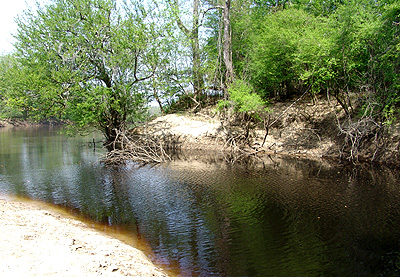
The S.C. Department of Natural Resources is currently conducting an eligibility study to designate the lower Lynches River as a State Scenic River.
The area under study, from about Lynches River County Park to the confluence with the Great Pee Dee River, features river swamps with towering cypress trees as well as sandy bluffs offering a wide variety of vegetation and wildlife. A section of the Lynches River, from Lee State Park to Lynches River County Park, was designated a Scenic River in 1994.
The goal of the Scenic Rivers program is the conservation of South Carolina’s river heritage through the proper management of the natural and cultural character of the state’s river corridors. An eligibility study is a research project to determine if the proposed river meets certain criteria to become a State Scenic River.
The Department of Natural Resources (DNR) staff conducts research to determine if the proposed river possesses “unique or outstanding scenic, recreational, geologic, botanical, fish, wildlife, historic, or cultural values.” The staff also compiles a draft study report, which is made available to the public for review and comments.
Contact the DNR at (803) 734-9100 for more information on the South Carolina Scenic Rivers Program or check the DNR Web site at www.dnr.sc.gov/water/envaff/river/scenicrivers.html.
“I have been on the Lynches River many times in my lifetime and can attest to the beauty of this wonderful natural resource in South Carolina,” said state Sen. Hugh Leatherman, representing Darlington and Florence counties. “I hope and trust that in the very near future Lynches River will be named a Scenic River.”
“Lynches River is a wonderful natural resource that flows through our backyard in Lower Florence County,” said Johnsonville Mayor Steve Dukes. “The river has been designated as a focal point for the City of Johnsonville Community Development and Design Plan. Proper management and conserving the natural beauty of the river will offer locals and tourists many opportunities to experience the wonders of nature for years to come.”
Austin Gilbert is a landowner on a riverfront section to be studied. “I’m delighted to have my section of Lynches River considered for inclusion in the Scenic River program,” Gilbert said. “This is a great way to preserve some of the natural beauty of the Pee Dee region. I hope future generations can enjoy the river as much as I have.”
“The Pee Dee Land Trust supports programs that enable landowners and other outdoor enthusiasts to collaborate on taking care of something they all appreciate and rely on,” said Jennie Williamson, director of the Pee Dee Land Trust. “The Scenic River projects do just that. Lynches River has a lot of people who care about its wellbeing, be they paddlers, fishermen, hunters, history buffs, farmers and forest landowners, industries or towns.”
There are five basic steps in the process of adding a river, or section of river, to the scenic rivers system:
* First, a written request from interested groups, individuals, landowners, local governments or other such entities is sent to the DNR requesting that a river be considered and a scenic river eligibility study be conducted.
* Second, staff of the DNR conducts the eligibility study. The study addresses scenic, cultural, historic, and natural values of the river corridor, as well as land use and water quality conditions. Findings of the study provide the information needed to determine if a river merits Scenic River designation and to classify the river into one of three categories: a natural river, a scenic river, or recreational river.
* The river-bordering landowners and the general public are
notified of the proposal for Scenic River designation and invited to public meetings to ask questions or express opinions.
* In addition, the county councils of each affected county are asked to provide a resolution of support for the scenic river proposal.
* Finally, the S.C. Natural Resources Board approves the proposal and then a bill is introduced in the General Assembly. The General Assembly designates the river as a State Scenic River.
If the river attains “Scenic River” status, DNR will appoint an advisory council, composed of riverfront landowners and others. The advisory council is charged with developing a management plan for the river. Compliance with the management plan is voluntary, but encouraged.
Scenic River status will allow the advisory council to comment on proposed activities that may change the river and address water quality problems. Thus the advisory council partnership, formed by DNR and local citizens, will help conserve the river long term. The partnership will also promote recreational use of this outstanding resource.
For example; a Scenic River Trail Guide is being developed for the upper portion, already given Scenic River status. Healthy, ethical recreational use of the river will be encouraged. Long term, the scenic river designation may enhance the quality of life in nearby communities and promote economic growth through tourism.
DNR protects and manages South Carolina’s natural resources by making wise and balanced decisions for the benefit of the state’s natural resources and its people. Find out more about DNR at www.dnr.sc.gov.



Be the first to comment